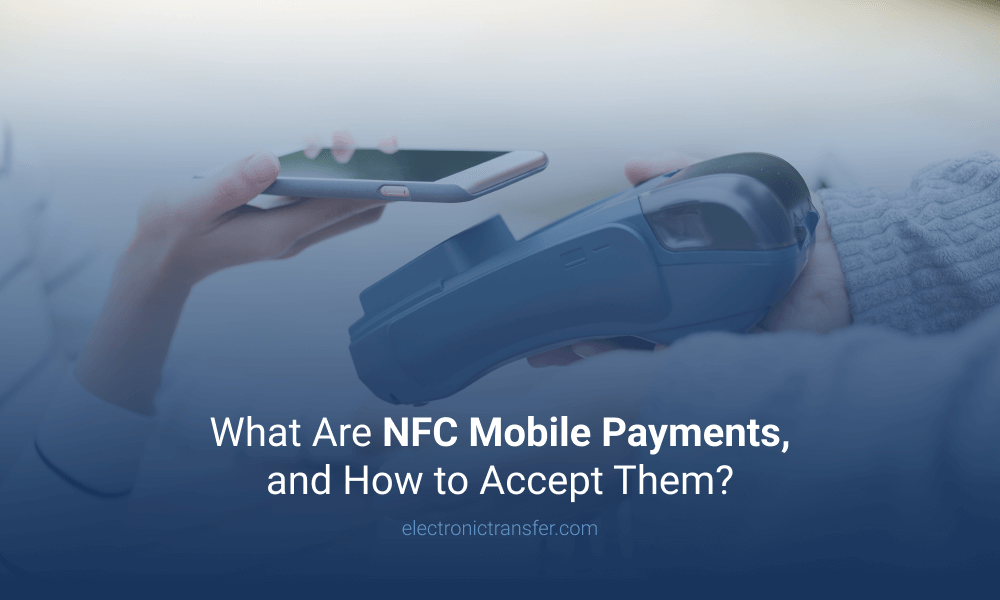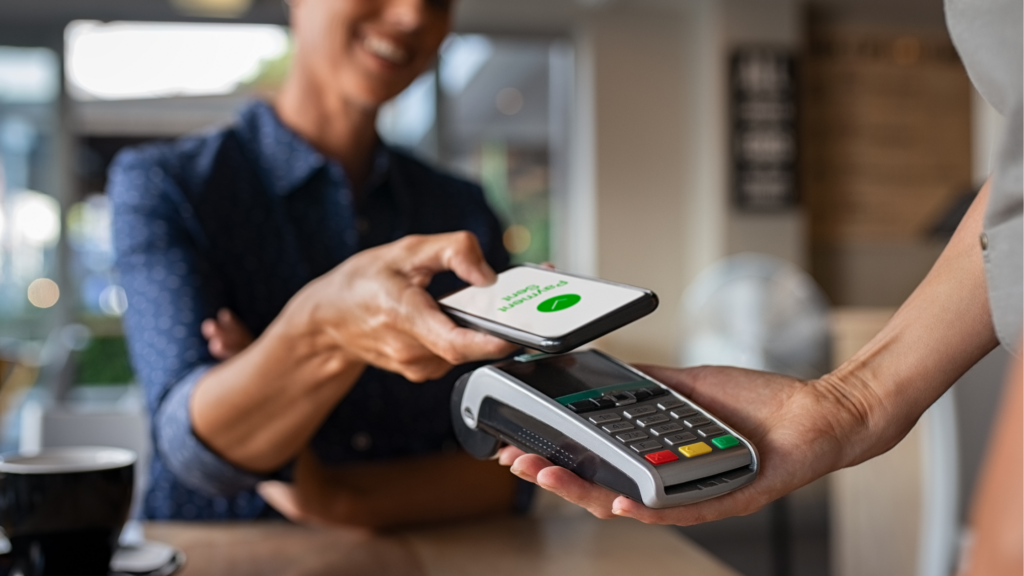[Updated 2025] What Are NFC Mobile Payments, and How to Accept Them?

In the last few years, you’ve probably noticed people waving their phones, smartwatches, or smart rings instead of swiping or inserting traditional plastic cards. They’re part of the NFC club, a touch-and-go contactless payment technology that is gaining popularity worldwide and changing the way people pay.
This article answers what NFC is, how it works, and explores its benefits for both parties, while addressing any concerns one might have about this technology.
What Is NFC Technology?
Near Field Communication (NFC) is like a handshake between devices. Its origins are from RFID (Radio Frequency Identification). Both use electromagnetic fields to exchange information wirelessly, but NFC is more secure and can perform more advanced functions. It’s similar to Bluetooth, but it works over much shorter distances and uses way less power.
NFC devices need to be really close (like within 10 cm, the length of your phone) to work. This close proximity ensures that the communication is secure and reduces the chance of interference or unauthorized access from a distance. It’s like whispering – you need to be right next to the person to hear them.
However this technology is not limited to just making payments. It has a wide range of applications that make daily tasks easier and more efficient. For instance, businesses can use it to track inventory by attaching special tags to products. Additionally, NFC can be used for security purposes, such as opening doors. Employees can simply tap their NFC-enabled ID cards on a reader to gain access to secure areas. This versatility makes it a valuable tool in various industries.
What Are NFC Mobile Payments and How Do They Work?
Let’s break down how this cool technology works:
1. First, you need a smartphone or other smart device that has NFC technology built-in. Most modern smartphones do.
2. Next, you have to set up a digital wallet on your phone. This is like a virtual version of your real wallet. You add your credit or debit card information to this app. Popular digital wallets include Apple Pay, Google Pay, and Samsung Pay.
3. When you’re ready to buy something, you need to look for a payment terminal that accepts contactless payments. These usually have a symbol that looks like a sideways Wi-Fi icon.
4. Next, you just wake up your phone and hold it close to the payment terminal. You might need to use your fingerprint, face recognition, or PIN to approve the payment.
5. The NFC chip in your phone talks to the payment terminal, sending over the necessary payment info. It’s all encrypted, so your actual card details aren’t shared.6. In just a second or two, your payment is processed, and you’re done!

Benefits of NFC Mobile Payments for Customers
NFC mobile payments offer a combo of pros that’s hard to beat. They’re making our financial lives easier and safer, one tap at a time.
- Convenience: First up, convenience. With NFC payments, you don’t have to fumble around for your wallet or count out exact change. Just tap your phone, and you’re good to go
- Speed: NFC payments are lightning fast! This is great for you when you’re in a hurry, and it’s awesome for stores too because they can serve more customers faster.
- Security: They are also super secure. When you tap to pay, your phone sends a special code instead of your actual card number. Even if someone somehow intercepted this code (which is really hard to do), they couldn’t use it to steal your money. Plus, most phones require a fingerprint, face scan, or PIN before they’ll make a payment, adding an extra layer of protection.
- Tracking spending: Each purchase is recorded in your phone’s payment app. This can be helpful for budgeting or just keeping an eye on your spending habits.
- NFC contactless payments are more hygienic: You don’t have to touch the keypad or hand over cash that’s been through hundreds of hands.
- Great for traveling: With this, your phone can often handle the currency conversion for you. Plus, you don’t have to worry about carrying around unfamiliar cash or whether a store will accept your credit card.
- Environmental angle: NFC payments reduce the need for physical cards and paper receipts. Over time, this can add up to a lot less plastic and paper waste. It’s a small thing, but every little bit helps when it comes to protecting our planet.
- Future-proof: Finally, they are future-proof. As technology advances, more and more places are accepting this form of payment. By getting comfortable with it now, you’re setting yourself up to breeze through payments in the future, no matter where you go.
Benefits for Businesses of Accepting NFC Mobile Payments
First, let’s dive into the benefits of accepting NFC mobile payments, then we can walk through the process of how to use this new purchasing method.
- Faster transactions: This system can serve customers faster than ever. A quick tap, and the payment is done! This means shorter lines, happier customers, and potentially more sales during peak hours.
- Improved customer experience: By offering NFC payments, you’re telling your customers, “We get it. We know you want things to be quick and easy.” This can lead to increased customer satisfaction and loyalty. Happy customers are more likely to come back and recommend your business to others.
- Reduced cash handling: Dealing with cash can be a hassle. It needs to be counted, stored securely, and taken to the bank. With more customers using NFC payments, you’ll have less cash to handle. This can save time, reduce errors in cash handling, and even lower the risk of theft.
- Attract tech-savvy customers: By accepting NFC payments, you’re positioning your business as forward-thinking and tech-friendly. This can help you attract and retain a valuable and younger customer base.
- Data and Insights: Many systems come with analytics tools. This information can help you make smarter business decisions.
- Future-proofing your business: As more people adopt mobile payments, businesses that don’t accept them might get left behind. By implementing NFC payments now, you’re preparing your business for the future of commerce.
How to Accept NFC Payments
Now, let’s walk through the process of how to accept NFC payments:
Step 1: Get the Right Equipment
First, you’ll need a payment terminal that can accept NFC payments. Many modern point-of-sale (POS) systems come with this capability built-in. If your current system doesn’t support it, you might need to upgrade or add an NFC-capable card reader.
Step 2: Choose a Payment Processor
You’ll need to work with a payment processor that supports NFC transactions. Many popular processors like Square, PayPal, and Stripe offer this service. Shop around to find one that fits your business needs and budget.
Step 3: Set Up Your System
Once you have your equipment and processor, it’s time to set everything up. This usually involves connecting your NFC-capable terminal to your payment processor’s system. Don’t worry – most providers offer step-by-step guides or customer support to help you through this process.
Step 4: Train Your Staff
Make sure your employees know how to use the new system. This might involve a quick training session and/or providing written instructions.
Step 5: Let Your Customers Know
Put up signs or stickers indicating that you accept NFC payments. Many payment processors provide these materials for free. You might also want to mention it on your website or social media to attract customers who prefer this payment method.
Step 6: Start Accepting Payments
When a customer wants to pay using NFC, they’ll simply hold their phone or contactless card near your payment terminal. The terminal will usually beep or light up to show the payment is being processed.
Step 7: Keep Your System Updated
Like any technology, NFC payment systems may need occasional updates. Make sure to keep your software current to maintain security and efficiency.
Safety Considerations for NFC Payments
If you’re wondering just how safe this purchasing method is, you’re not alone. It’s natural to be cautious when it comes to new technology. Let’s address some common concerns.
First off, let’s put your mind at ease: accepting NFC payments is safe for both businesses and customers. In fact, in many ways, it’s even safer than traditional payment methods.
Here’s why:
- Encrypted data: When you tap your phone to make a payment, the information sent between your device and the payment terminal is encrypted.
- Tokenization: Instead of sending your actual credit card number, NFC payments use a unique, one-time code for each transaction.
- Short range: It only works over very short distances – this means you have to be really close to the payment terminal to make a transaction.
- Additional security measures: Most phones require you to unlock them before making an NFC payment. This might be with your fingerprint, face recognition, or a PIN. So even if someone stole your phone, they couldn’t just start making payments without getting past this security step.
Now, let’s address those concerns:
- “Can hackers intercept my payment info?”: It’s extremely unlikely. The encryption and tokenization make it nearly impossible for hackers to get any useful information, even if they could intercept the signal.
- “Is it safe for my business to accept NFC payments?”: Absolutely! NFC payments can actually reduce the risk of fraud. Plus, the responsibility for securing the payment usually lies with the payment processor, not your business.
- “What about the safety of my personal data?”: NFC payments typically don’t store personal data on the merchant’s system. This means there’s less risk of your information being compromised if a business’s systems are hacked.
- “Are NFC payments as safe as chip-and-PIN?”: Yes, they’re considered just as safe, if not safer. NFC payments use similar security technology to chip-and-PIN, with the added benefit of tokenization.
It’s worth noting that payment companies and tech firms are constantly working to improve the security of NFC payments. They’re always updating their systems to stay ahead of potential threats.
Wrap Up
NFC mobile payments are making our lives easier and our finances more secure for both customers and businesses alike. With encryption technology ensuring your data remains protected, NFC mobile payments are a reliable alternative to traditional methods.


